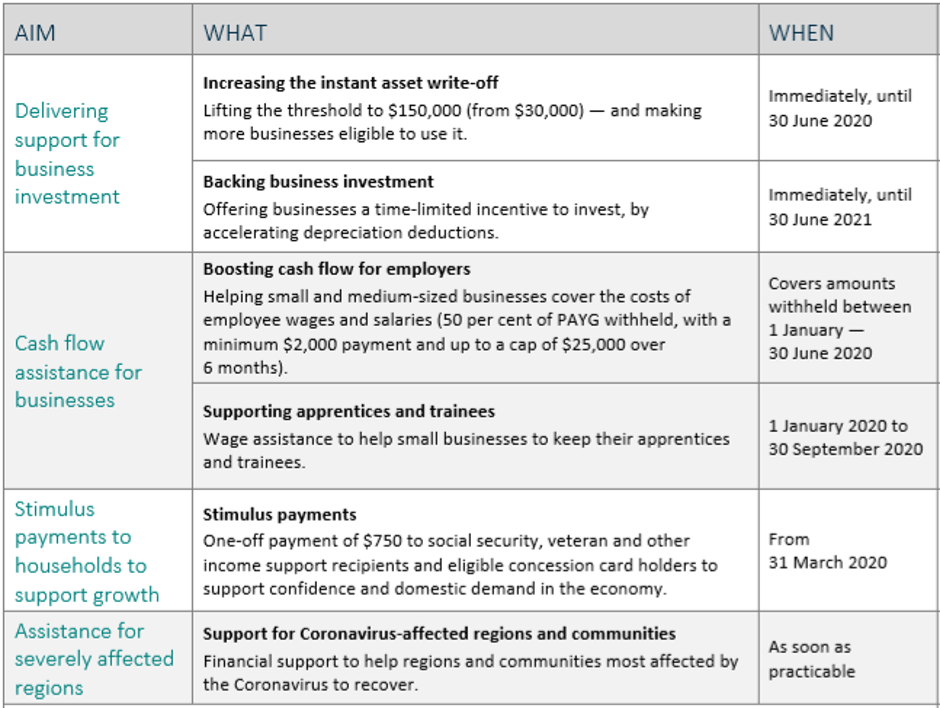
In a little over 2 months since the initial reporting of a new virus, the world has entered an unprecedented period of uncertainty. The full extent of the outbreak and its impacts (both humanitarian and economic) are not yet fully understood and may not be for some time. That being said, now is the time to be proactive.
Business owners must be initiating investigations and looking at the ‘big picture’. Aim to understand in different scenarios what the impacts of COVID-19 may be and how you might be able to put in place steps now in order to limit the negatives impacts.
We have collated below a checklist in order to help you approach a ‘big picture’ planning exercise and provided information regarding the ATO and the Australian Government’s response to the outbreak.
Checklist
- Protect your most important asset: Your employees!
- Follow the advice from health authorities (e.g. Australian Government Department of Health)
- Communicate with employees calmly, frequently and with the right specificity; support any affected employees per health guidance available – your people are looking to you as a leader now more than ever!
- Consider scrapping non-essential efforts (e.g. some businesses have halted non-essential travel).
- Understand your employer obligations and implications for employee entitlements (e.g. Fair Work Act 2009 (Cth), Occupational Health and Safety Act 2004 (VIC))
- Set up a Response Team
- Led by the MD, General Manager/CEO/Owner
- Your Response Team’s plan should cover:
- employees
- financial stress-testing and contingency plans
- supply chain considerations
- marketing and sales
- other relevant stakeholders
- Define specific weekly action items for each section of your plan
- Ensure a simple but well managed operating rhythm and discipline that’s output and decision focused. Low tolerance for “meetings for the sake of meetings”.
- Present on the minimum:
- a rolling 6-week calendar of milestones (whiteboard for all to see)
- 1-page plans for each workstream (no more)
- dashboard of progress and triggers (traffic light reporting works best and is quickest to absorb)
- threat map (where are the closest and most serious threats)
- Who is communicating the plans to your teams? Who should your people turn to in the business if they have concerns?
- Test for stress, ensure liquidity (“cash is king”), build contingency plans and sure up your banking/finance relationships
- Define ‘what-if’ scenarios that are tailored to the business (e.g. stock shortages arise, sales decline, staff member contracts coronavirus and all staff are quarantined, etc).
- Model income & expenses, cash flows, and balance sheet in each scenario; identify input-variable triggers that could drive significant liquidity events (including breach of covenants) – Cashflow is most important
- Identify trigger-based moves to stabilise organisation in each scenario (from A/P, A/R optimisation; cost reduction including deferral of projects or reducing staff headcount; to subletting of excess space or crunching a deal with your landlord for a reduced rent.
- Communicate with your bank and financier, report any cashflow stress and agree terms (check your covenants, these are some of the things where you may need to seek temporary relief from your financier). Look to renegotiate ideally interest free terms, or a deferral of principle reductions on any existing debt facilities.
- Understand and “sure up” your supply chain
- Understand extent and timing of exposure to areas that are experiencing community transmission (i.e. will stock orders from overseas arrive when expected?).
- Speak to your suppliers, understand where they are stressed and where you fit in, schedule accordingly.
- ¨Immediate stabilisation (seek out alternative supplies for product if possible, or alternatively, look at ways to capture initial sales and agree deferred delivery dates to any customers - i.e. bring in the cash now and supply the product to the customer at a later date).
- Medium/longer-term stabilisation (updated demand planning and network optimisation – solve for cash, find alternative suppliers, drive resilience in supply chain).
- Contact your customers constantly
- Immediate stabilisation (advertise the proactive approach you are taking in terms of providing a clean, safe environment for your customers and their families, inventory planning, near-term pricing changes).
- Medium/longer-term stabilisation (investment and targeting for priority segments with long-term growth).
- Practice your plan
- Define triggers for different phases of response (think fire drills for the different scenarios you have defined)
- Key considerations:
- clarity on decision owner (who are your people going to turn to when a decision needs to be made)
- roles for each key person from your leadership team
- what investment do you need to carry out your plans?
- Demonstrate purpose
- Do not hesitate if actual plans must be enacted
Given we have entered one of the most uncertain periods of recent memory, leaders will find themselves having to make very tough decisions. In the face of that, being as prepared as possible is key and following the already outlined plan will go a long way in assisting in this regard.
Should you wish to understand more about this planning process, and their application to your business, please do not hesitate to contact your Fordham Partner.
Information from the ATO
Below is a summary of information provided by the ATO in the event your business is impacted by COVID-19.
- Payment deferrals – the ATO can work with you to defer some payments and vary instalments you have due, such as income tax, activity statements, FBT and excise payments by up to four months.
- Monthly GST credits – Businesses on a quarterly reporting cycle may elect to change their GST reporting and payment to monthly, to get quicker access to GST refunds you are entitled to. You can only change from the start of a quarter, so a change now will take effect from 1 April 2020. If you're registered for fuel tax credits, and change your GST reporting from quarterly to monthly, you will also need to claim your fuel tax credits monthly.
- PAYG Instalments – If you are a quarterly pay as you go (PAYG) instalments payer, you can vary your PAYG instalments on your activity statement for the March 2020 quarter. You can do this by lodging a revised activity statement before your instalment is due and before you lodge your tax return for the year. Businesses that vary their PAYG instalment rate or amount can also claim a refund for any instalments made for the September 2019 and December 2019 quarters.
- Remitting interest and penalties – Where your business is affected by COVID-19, the ATO will consider remitting interest and penalties applied to tax liabilities incurred after 23 January 2020.
- Low interest payment plans – If your business has been affected by COVID-19 and you need help to pay your existing and ongoing tax liabilities, you can contact the ATO to discuss entering a low interest payment plan.
- Super guarantee payments – Employers still need to meet super guarantee obligations for their employees. By law, the ATO can't vary the contribution due date or waive the super guarantee charge where super guarantee payments late or unpaid.
The ATO contact emergency support Infoline is 1800 806 218 should you need to arrange a tailored plan for your situation. Of course Fordham is here to help coordinate your needs.
Australian Government Economic Response to the Coronavirus
The Australian Government has implemented an economic response package that will address economic impacts of the Coronavirus outbreak. A summary of this response is below and further information can be found here.

Should you wish to discuss these matters further, please contact your Fordham Partner.

